Business Model Analysis: Implementation and Strategic Implications
VerifiedAdded on 2021/04/17
|13
|3014
|210
Report
AI Summary
This report provides a comprehensive analysis of business model implementation, contrasting it with the traditional strategic management approach. It explores the advantages and disadvantages of each approach, highlighting the limitations of traditional strategic management, such as its complexity and time-consuming nature, compared to the more adaptable and holistic business model framework. The report delves into the differences between business models and strategies, explaining how business models focus on value creation, revenue generation, and customer relationships, while strategies outline the long-term direction of the organization. Furthermore, the report examines how business models address the limitations of traditional approaches and suggests changes that can be made to improve strategy formulation. It also includes a discussion of the Business Model Canvas as a tool for understanding the key aspects of a business. The paper emphasizes the increasing popularity of business models in the modern business environment and offers a detailed comparison of the two approaches, offering insights into how organizations can achieve competitive advantage and adapt to the changing market dynamics.
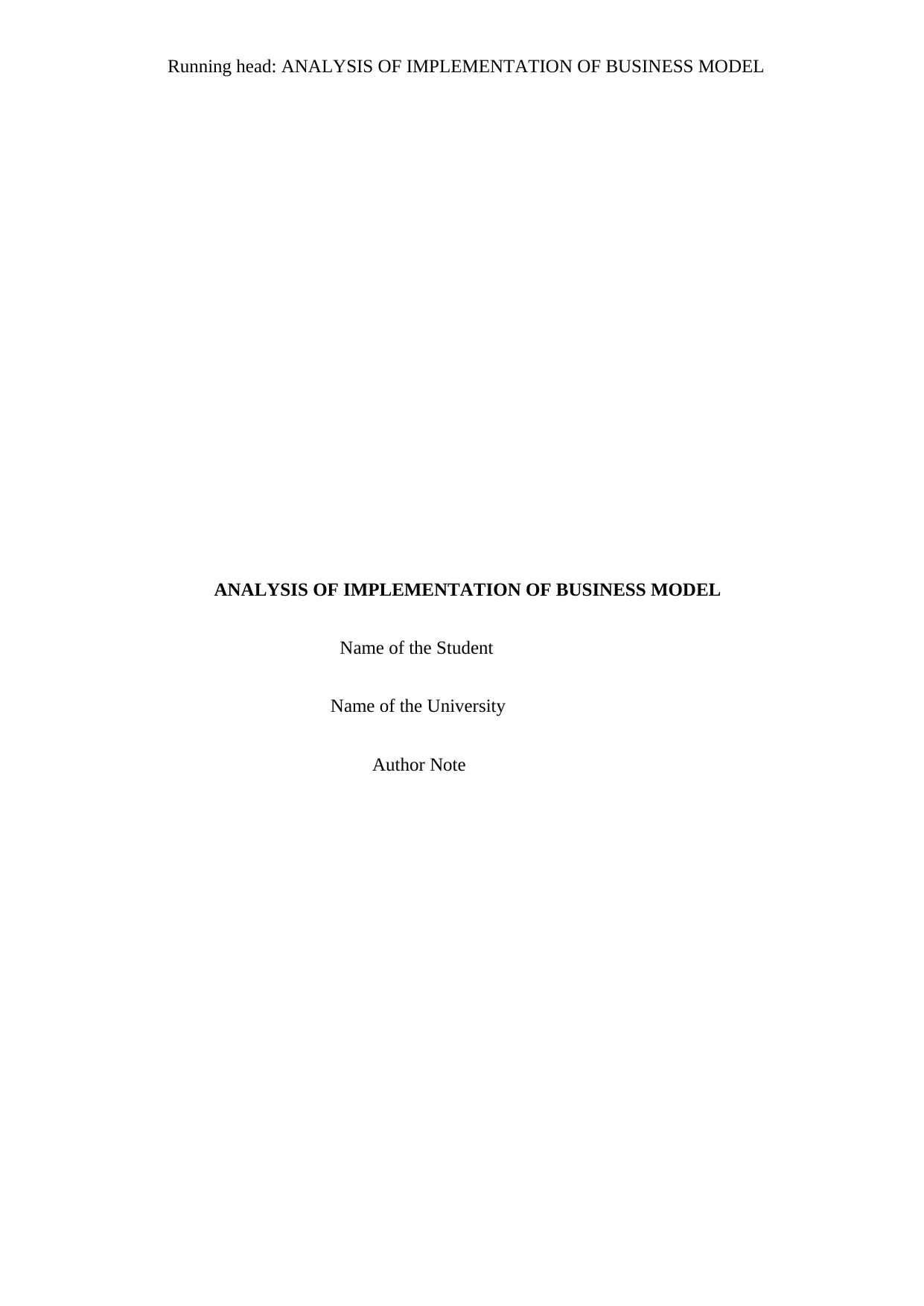
Running head: ANALYSIS OF IMPLEMENTATION OF BUSINESS MODEL
ANALYSIS OF IMPLEMENTATION OF BUSINESS MODEL
Name of the Student
Name of the University
Author Note
ANALYSIS OF IMPLEMENTATION OF BUSINESS MODEL
Name of the Student
Name of the University
Author Note
Paraphrase This Document
Need a fresh take? Get an instant paraphrase of this document with our AI Paraphraser
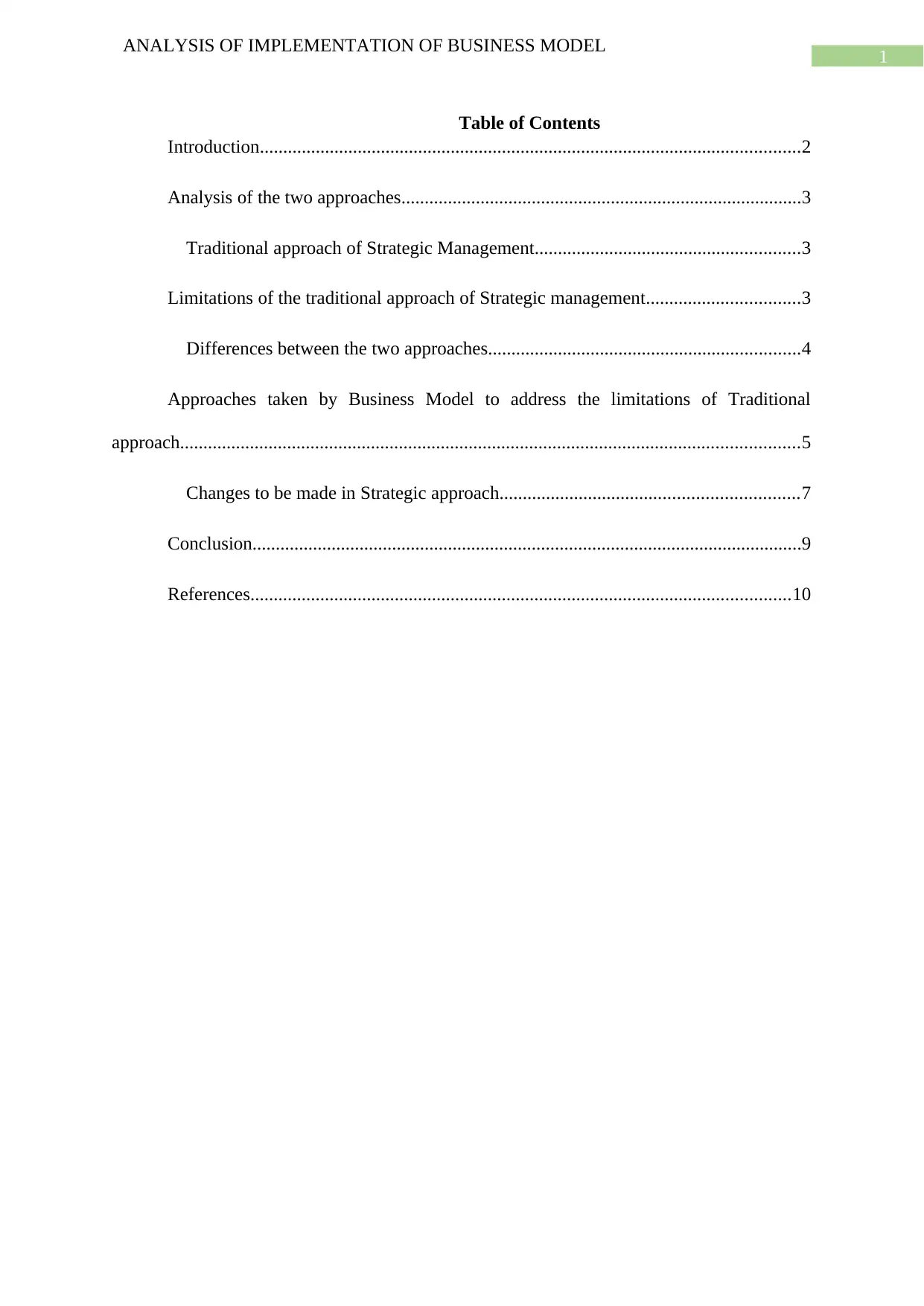
1
ANALYSIS OF IMPLEMENTATION OF BUSINESS MODEL
Table of Contents
Introduction....................................................................................................................2
Analysis of the two approaches......................................................................................3
Traditional approach of Strategic Management.........................................................3
Limitations of the traditional approach of Strategic management.................................3
Differences between the two approaches...................................................................4
Approaches taken by Business Model to address the limitations of Traditional
approach.....................................................................................................................................5
Changes to be made in Strategic approach................................................................7
Conclusion......................................................................................................................9
References....................................................................................................................10
ANALYSIS OF IMPLEMENTATION OF BUSINESS MODEL
Table of Contents
Introduction....................................................................................................................2
Analysis of the two approaches......................................................................................3
Traditional approach of Strategic Management.........................................................3
Limitations of the traditional approach of Strategic management.................................3
Differences between the two approaches...................................................................4
Approaches taken by Business Model to address the limitations of Traditional
approach.....................................................................................................................................5
Changes to be made in Strategic approach................................................................7
Conclusion......................................................................................................................9
References....................................................................................................................10
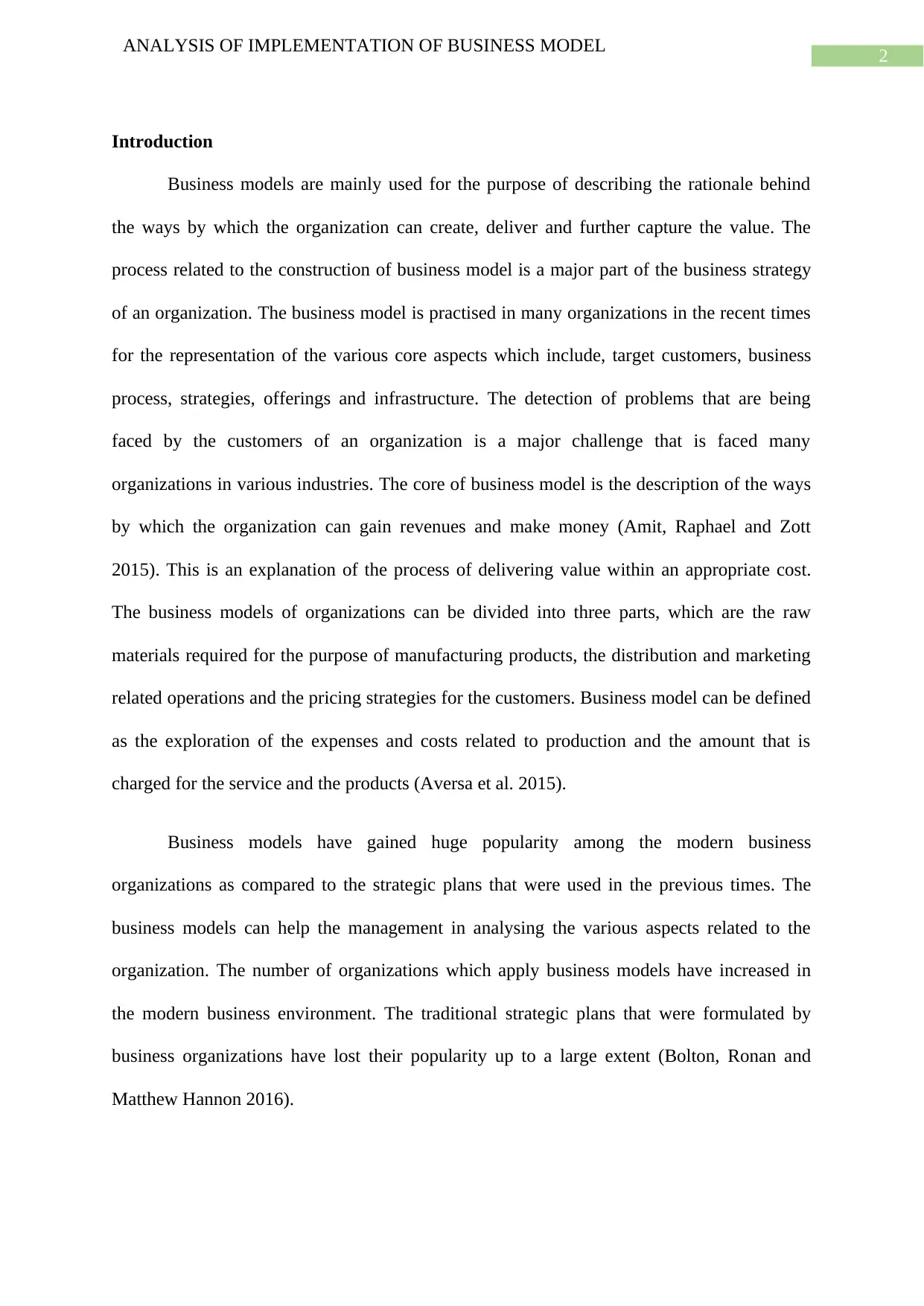
2
ANALYSIS OF IMPLEMENTATION OF BUSINESS MODEL
Introduction
Business models are mainly used for the purpose of describing the rationale behind
the ways by which the organization can create, deliver and further capture the value. The
process related to the construction of business model is a major part of the business strategy
of an organization. The business model is practised in many organizations in the recent times
for the representation of the various core aspects which include, target customers, business
process, strategies, offerings and infrastructure. The detection of problems that are being
faced by the customers of an organization is a major challenge that is faced many
organizations in various industries. The core of business model is the description of the ways
by which the organization can gain revenues and make money (Amit, Raphael and Zott
2015). This is an explanation of the process of delivering value within an appropriate cost.
The business models of organizations can be divided into three parts, which are the raw
materials required for the purpose of manufacturing products, the distribution and marketing
related operations and the pricing strategies for the customers. Business model can be defined
as the exploration of the expenses and costs related to production and the amount that is
charged for the service and the products (Aversa et al. 2015).
Business models have gained huge popularity among the modern business
organizations as compared to the strategic plans that were used in the previous times. The
business models can help the management in analysing the various aspects related to the
organization. The number of organizations which apply business models have increased in
the modern business environment. The traditional strategic plans that were formulated by
business organizations have lost their popularity up to a large extent (Bolton, Ronan and
Matthew Hannon 2016).
ANALYSIS OF IMPLEMENTATION OF BUSINESS MODEL
Introduction
Business models are mainly used for the purpose of describing the rationale behind
the ways by which the organization can create, deliver and further capture the value. The
process related to the construction of business model is a major part of the business strategy
of an organization. The business model is practised in many organizations in the recent times
for the representation of the various core aspects which include, target customers, business
process, strategies, offerings and infrastructure. The detection of problems that are being
faced by the customers of an organization is a major challenge that is faced many
organizations in various industries. The core of business model is the description of the ways
by which the organization can gain revenues and make money (Amit, Raphael and Zott
2015). This is an explanation of the process of delivering value within an appropriate cost.
The business models of organizations can be divided into three parts, which are the raw
materials required for the purpose of manufacturing products, the distribution and marketing
related operations and the pricing strategies for the customers. Business model can be defined
as the exploration of the expenses and costs related to production and the amount that is
charged for the service and the products (Aversa et al. 2015).
Business models have gained huge popularity among the modern business
organizations as compared to the strategic plans that were used in the previous times. The
business models can help the management in analysing the various aspects related to the
organization. The number of organizations which apply business models have increased in
the modern business environment. The traditional strategic plans that were formulated by
business organizations have lost their popularity up to a large extent (Bolton, Ronan and
Matthew Hannon 2016).
⊘ This is a preview!⊘
Do you want full access?
Subscribe today to unlock all pages.

Trusted by 1+ million students worldwide
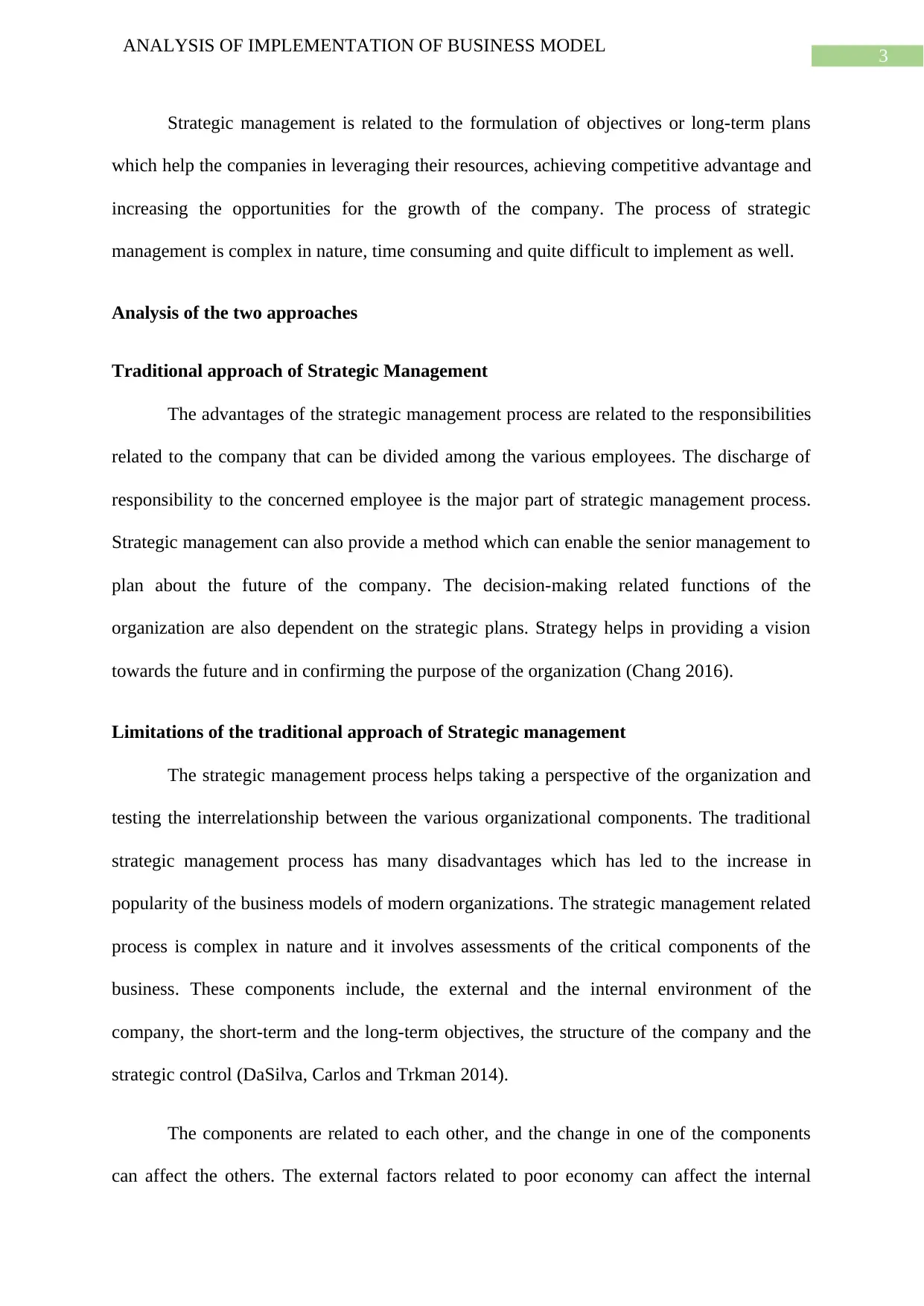
3
ANALYSIS OF IMPLEMENTATION OF BUSINESS MODEL
Strategic management is related to the formulation of objectives or long-term plans
which help the companies in leveraging their resources, achieving competitive advantage and
increasing the opportunities for the growth of the company. The process of strategic
management is complex in nature, time consuming and quite difficult to implement as well.
Analysis of the two approaches
Traditional approach of Strategic Management
The advantages of the strategic management process are related to the responsibilities
related to the company that can be divided among the various employees. The discharge of
responsibility to the concerned employee is the major part of strategic management process.
Strategic management can also provide a method which can enable the senior management to
plan about the future of the company. The decision-making related functions of the
organization are also dependent on the strategic plans. Strategy helps in providing a vision
towards the future and in confirming the purpose of the organization (Chang 2016).
Limitations of the traditional approach of Strategic management
The strategic management process helps taking a perspective of the organization and
testing the interrelationship between the various organizational components. The traditional
strategic management process has many disadvantages which has led to the increase in
popularity of the business models of modern organizations. The strategic management related
process is complex in nature and it involves assessments of the critical components of the
business. These components include, the external and the internal environment of the
company, the short-term and the long-term objectives, the structure of the company and the
strategic control (DaSilva, Carlos and Trkman 2014).
The components are related to each other, and the change in one of the components
can affect the others. The external factors related to poor economy can affect the internal
ANALYSIS OF IMPLEMENTATION OF BUSINESS MODEL
Strategic management is related to the formulation of objectives or long-term plans
which help the companies in leveraging their resources, achieving competitive advantage and
increasing the opportunities for the growth of the company. The process of strategic
management is complex in nature, time consuming and quite difficult to implement as well.
Analysis of the two approaches
Traditional approach of Strategic Management
The advantages of the strategic management process are related to the responsibilities
related to the company that can be divided among the various employees. The discharge of
responsibility to the concerned employee is the major part of strategic management process.
Strategic management can also provide a method which can enable the senior management to
plan about the future of the company. The decision-making related functions of the
organization are also dependent on the strategic plans. Strategy helps in providing a vision
towards the future and in confirming the purpose of the organization (Chang 2016).
Limitations of the traditional approach of Strategic management
The strategic management process helps taking a perspective of the organization and
testing the interrelationship between the various organizational components. The traditional
strategic management process has many disadvantages which has led to the increase in
popularity of the business models of modern organizations. The strategic management related
process is complex in nature and it involves assessments of the critical components of the
business. These components include, the external and the internal environment of the
company, the short-term and the long-term objectives, the structure of the company and the
strategic control (DaSilva, Carlos and Trkman 2014).
The components are related to each other, and the change in one of the components
can affect the others. The external factors related to poor economy can affect the internal
Paraphrase This Document
Need a fresh take? Get an instant paraphrase of this document with our AI Paraphraser
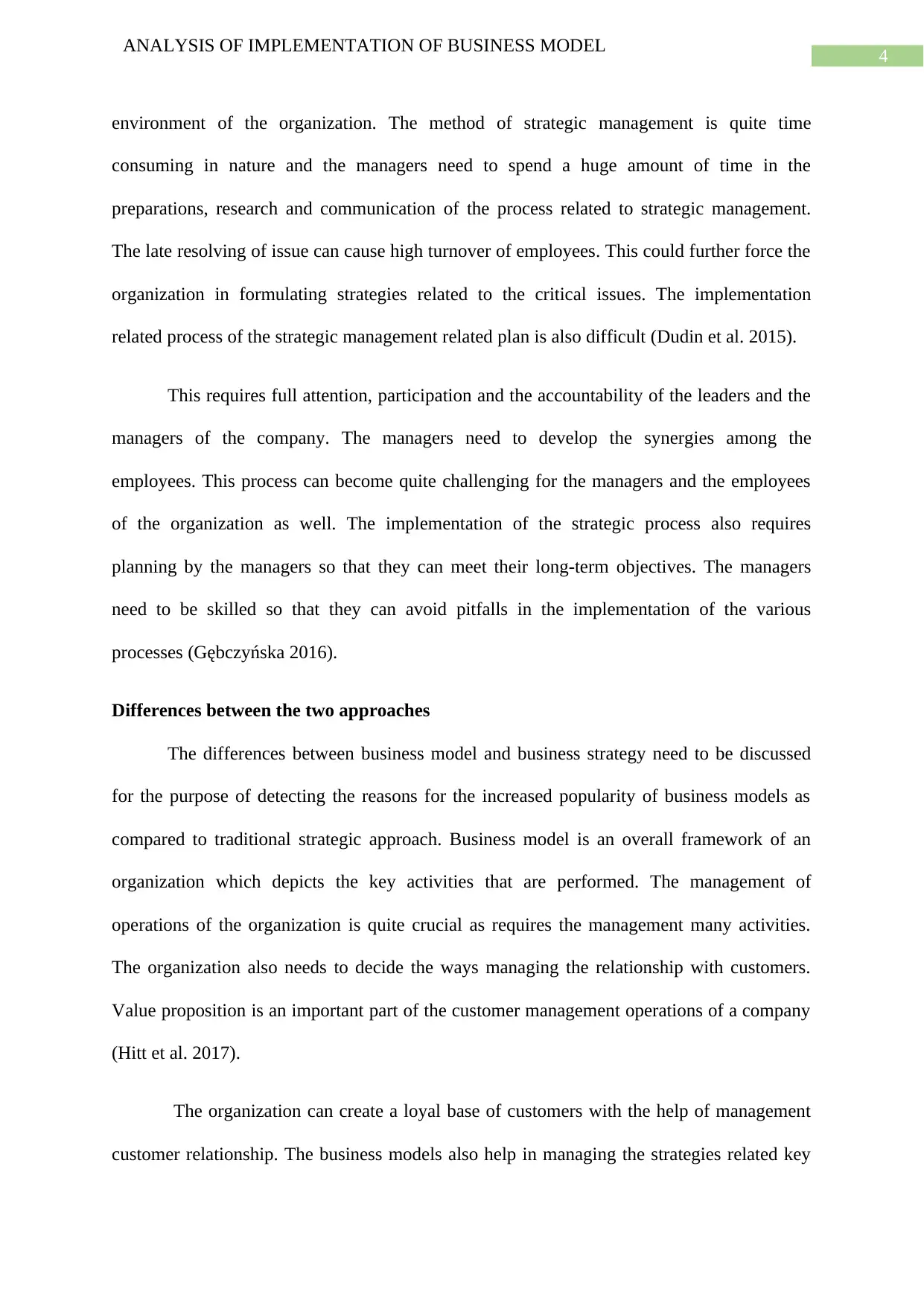
4
ANALYSIS OF IMPLEMENTATION OF BUSINESS MODEL
environment of the organization. The method of strategic management is quite time
consuming in nature and the managers need to spend a huge amount of time in the
preparations, research and communication of the process related to strategic management.
The late resolving of issue can cause high turnover of employees. This could further force the
organization in formulating strategies related to the critical issues. The implementation
related process of the strategic management related plan is also difficult (Dudin et al. 2015).
This requires full attention, participation and the accountability of the leaders and the
managers of the company. The managers need to develop the synergies among the
employees. This process can become quite challenging for the managers and the employees
of the organization as well. The implementation of the strategic process also requires
planning by the managers so that they can meet their long-term objectives. The managers
need to be skilled so that they can avoid pitfalls in the implementation of the various
processes (Gębczyńska 2016).
Differences between the two approaches
The differences between business model and business strategy need to be discussed
for the purpose of detecting the reasons for the increased popularity of business models as
compared to traditional strategic approach. Business model is an overall framework of an
organization which depicts the key activities that are performed. The management of
operations of the organization is quite crucial as requires the management many activities.
The organization also needs to decide the ways managing the relationship with customers.
Value proposition is an important part of the customer management operations of a company
(Hitt et al. 2017).
The organization can create a loyal base of customers with the help of management
customer relationship. The business models also help in managing the strategies related key
ANALYSIS OF IMPLEMENTATION OF BUSINESS MODEL
environment of the organization. The method of strategic management is quite time
consuming in nature and the managers need to spend a huge amount of time in the
preparations, research and communication of the process related to strategic management.
The late resolving of issue can cause high turnover of employees. This could further force the
organization in formulating strategies related to the critical issues. The implementation
related process of the strategic management related plan is also difficult (Dudin et al. 2015).
This requires full attention, participation and the accountability of the leaders and the
managers of the company. The managers need to develop the synergies among the
employees. This process can become quite challenging for the managers and the employees
of the organization as well. The implementation of the strategic process also requires
planning by the managers so that they can meet their long-term objectives. The managers
need to be skilled so that they can avoid pitfalls in the implementation of the various
processes (Gębczyńska 2016).
Differences between the two approaches
The differences between business model and business strategy need to be discussed
for the purpose of detecting the reasons for the increased popularity of business models as
compared to traditional strategic approach. Business model is an overall framework of an
organization which depicts the key activities that are performed. The management of
operations of the organization is quite crucial as requires the management many activities.
The organization also needs to decide the ways managing the relationship with customers.
Value proposition is an important part of the customer management operations of a company
(Hitt et al. 2017).
The organization can create a loyal base of customers with the help of management
customer relationship. The business models also help in managing the strategies related key
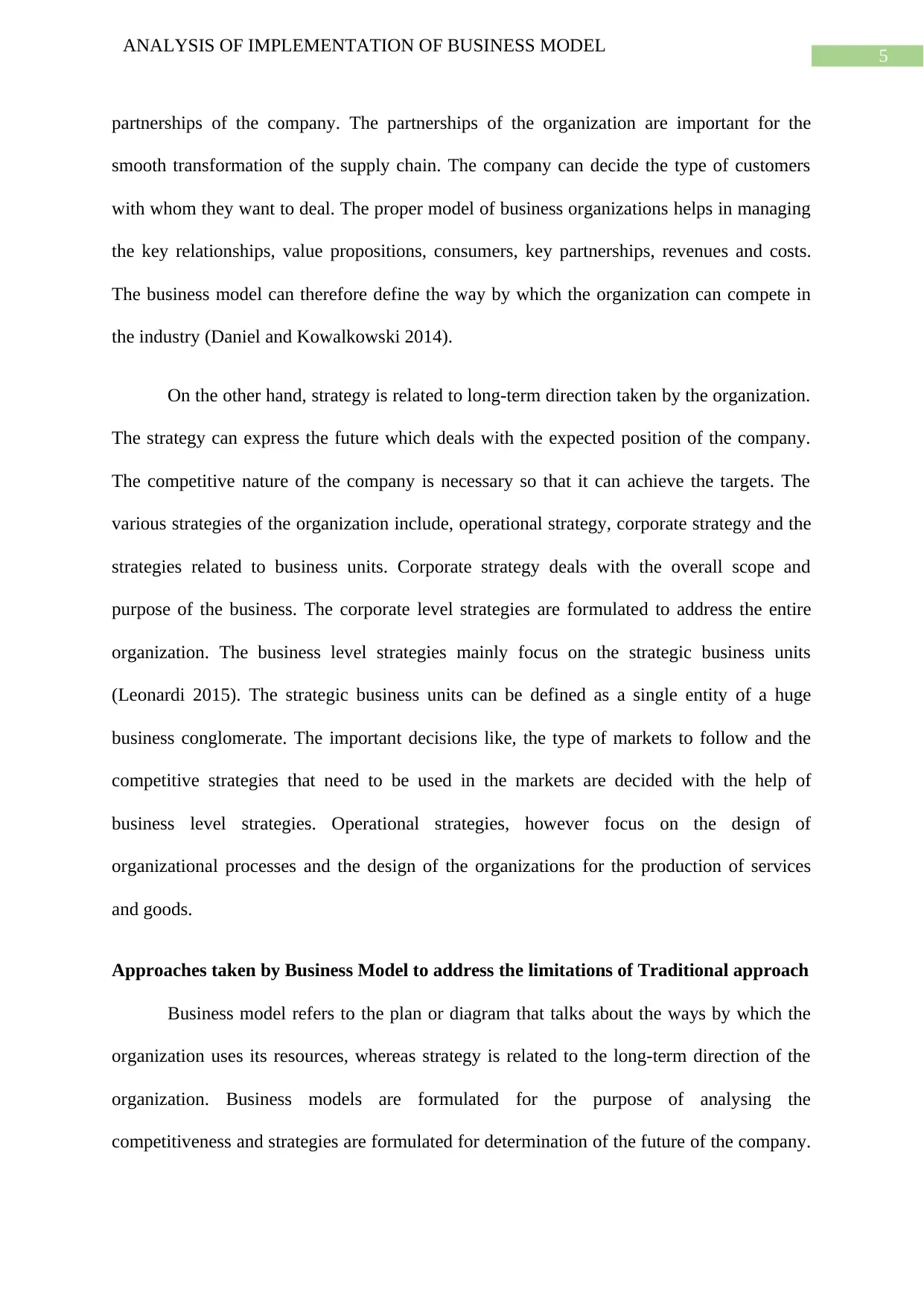
5
ANALYSIS OF IMPLEMENTATION OF BUSINESS MODEL
partnerships of the company. The partnerships of the organization are important for the
smooth transformation of the supply chain. The company can decide the type of customers
with whom they want to deal. The proper model of business organizations helps in managing
the key relationships, value propositions, consumers, key partnerships, revenues and costs.
The business model can therefore define the way by which the organization can compete in
the industry (Daniel and Kowalkowski 2014).
On the other hand, strategy is related to long-term direction taken by the organization.
The strategy can express the future which deals with the expected position of the company.
The competitive nature of the company is necessary so that it can achieve the targets. The
various strategies of the organization include, operational strategy, corporate strategy and the
strategies related to business units. Corporate strategy deals with the overall scope and
purpose of the business. The corporate level strategies are formulated to address the entire
organization. The business level strategies mainly focus on the strategic business units
(Leonardi 2015). The strategic business units can be defined as a single entity of a huge
business conglomerate. The important decisions like, the type of markets to follow and the
competitive strategies that need to be used in the markets are decided with the help of
business level strategies. Operational strategies, however focus on the design of
organizational processes and the design of the organizations for the production of services
and goods.
Approaches taken by Business Model to address the limitations of Traditional approach
Business model refers to the plan or diagram that talks about the ways by which the
organization uses its resources, whereas strategy is related to the long-term direction of the
organization. Business models are formulated for the purpose of analysing the
competitiveness and strategies are formulated for determination of the future of the company.
ANALYSIS OF IMPLEMENTATION OF BUSINESS MODEL
partnerships of the company. The partnerships of the organization are important for the
smooth transformation of the supply chain. The company can decide the type of customers
with whom they want to deal. The proper model of business organizations helps in managing
the key relationships, value propositions, consumers, key partnerships, revenues and costs.
The business model can therefore define the way by which the organization can compete in
the industry (Daniel and Kowalkowski 2014).
On the other hand, strategy is related to long-term direction taken by the organization.
The strategy can express the future which deals with the expected position of the company.
The competitive nature of the company is necessary so that it can achieve the targets. The
various strategies of the organization include, operational strategy, corporate strategy and the
strategies related to business units. Corporate strategy deals with the overall scope and
purpose of the business. The corporate level strategies are formulated to address the entire
organization. The business level strategies mainly focus on the strategic business units
(Leonardi 2015). The strategic business units can be defined as a single entity of a huge
business conglomerate. The important decisions like, the type of markets to follow and the
competitive strategies that need to be used in the markets are decided with the help of
business level strategies. Operational strategies, however focus on the design of
organizational processes and the design of the organizations for the production of services
and goods.
Approaches taken by Business Model to address the limitations of Traditional approach
Business model refers to the plan or diagram that talks about the ways by which the
organization uses its resources, whereas strategy is related to the long-term direction of the
organization. Business models are formulated for the purpose of analysing the
competitiveness and strategies are formulated for determination of the future of the company.
⊘ This is a preview!⊘
Do you want full access?
Subscribe today to unlock all pages.

Trusted by 1+ million students worldwide
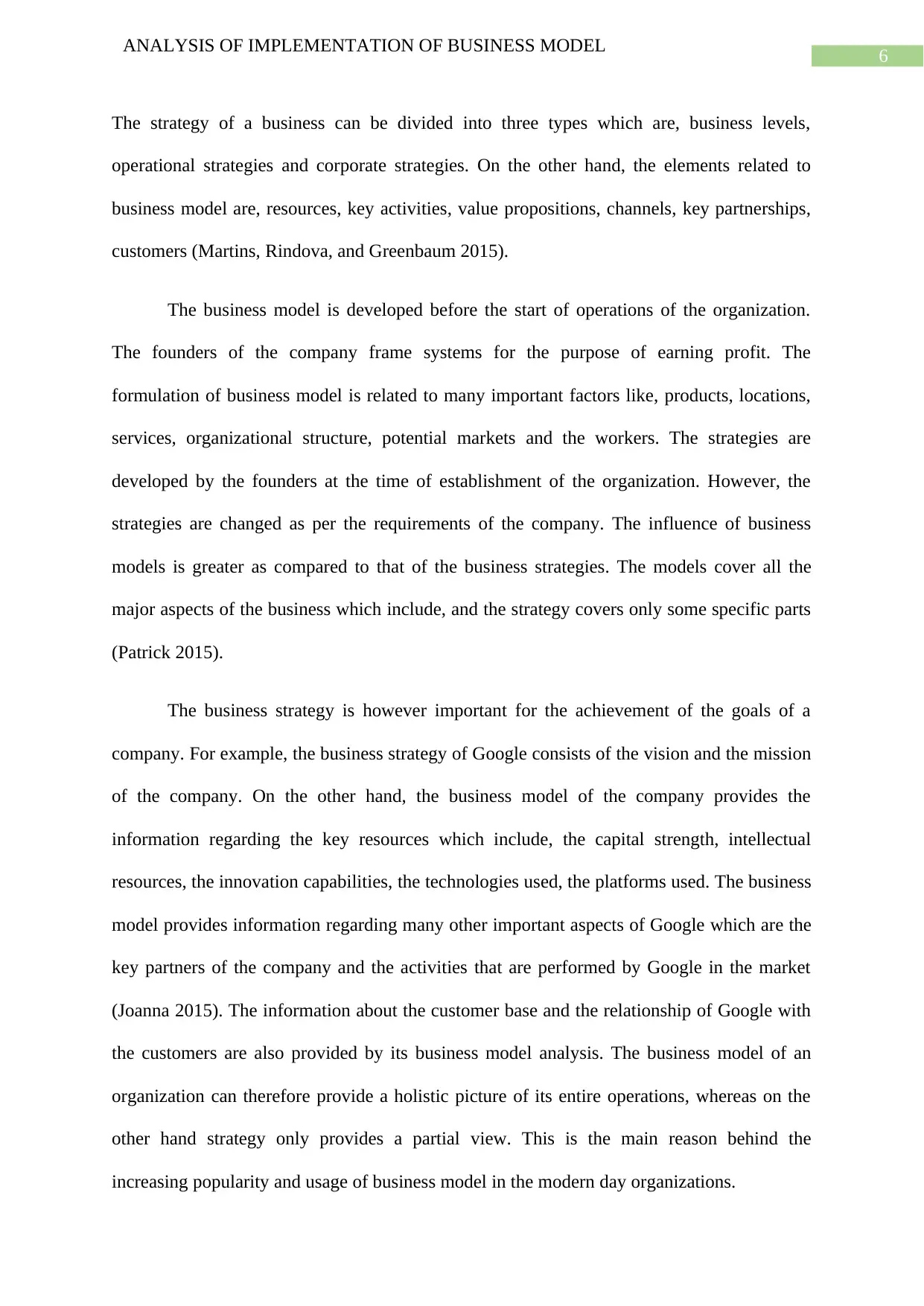
6
ANALYSIS OF IMPLEMENTATION OF BUSINESS MODEL
The strategy of a business can be divided into three types which are, business levels,
operational strategies and corporate strategies. On the other hand, the elements related to
business model are, resources, key activities, value propositions, channels, key partnerships,
customers (Martins, Rindova, and Greenbaum 2015).
The business model is developed before the start of operations of the organization.
The founders of the company frame systems for the purpose of earning profit. The
formulation of business model is related to many important factors like, products, locations,
services, organizational structure, potential markets and the workers. The strategies are
developed by the founders at the time of establishment of the organization. However, the
strategies are changed as per the requirements of the company. The influence of business
models is greater as compared to that of the business strategies. The models cover all the
major aspects of the business which include, and the strategy covers only some specific parts
(Patrick 2015).
The business strategy is however important for the achievement of the goals of a
company. For example, the business strategy of Google consists of the vision and the mission
of the company. On the other hand, the business model of the company provides the
information regarding the key resources which include, the capital strength, intellectual
resources, the innovation capabilities, the technologies used, the platforms used. The business
model provides information regarding many other important aspects of Google which are the
key partners of the company and the activities that are performed by Google in the market
(Joanna 2015). The information about the customer base and the relationship of Google with
the customers are also provided by its business model analysis. The business model of an
organization can therefore provide a holistic picture of its entire operations, whereas on the
other hand strategy only provides a partial view. This is the main reason behind the
increasing popularity and usage of business model in the modern day organizations.
ANALYSIS OF IMPLEMENTATION OF BUSINESS MODEL
The strategy of a business can be divided into three types which are, business levels,
operational strategies and corporate strategies. On the other hand, the elements related to
business model are, resources, key activities, value propositions, channels, key partnerships,
customers (Martins, Rindova, and Greenbaum 2015).
The business model is developed before the start of operations of the organization.
The founders of the company frame systems for the purpose of earning profit. The
formulation of business model is related to many important factors like, products, locations,
services, organizational structure, potential markets and the workers. The strategies are
developed by the founders at the time of establishment of the organization. However, the
strategies are changed as per the requirements of the company. The influence of business
models is greater as compared to that of the business strategies. The models cover all the
major aspects of the business which include, and the strategy covers only some specific parts
(Patrick 2015).
The business strategy is however important for the achievement of the goals of a
company. For example, the business strategy of Google consists of the vision and the mission
of the company. On the other hand, the business model of the company provides the
information regarding the key resources which include, the capital strength, intellectual
resources, the innovation capabilities, the technologies used, the platforms used. The business
model provides information regarding many other important aspects of Google which are the
key partners of the company and the activities that are performed by Google in the market
(Joanna 2015). The information about the customer base and the relationship of Google with
the customers are also provided by its business model analysis. The business model of an
organization can therefore provide a holistic picture of its entire operations, whereas on the
other hand strategy only provides a partial view. This is the main reason behind the
increasing popularity and usage of business model in the modern day organizations.
Paraphrase This Document
Need a fresh take? Get an instant paraphrase of this document with our AI Paraphraser
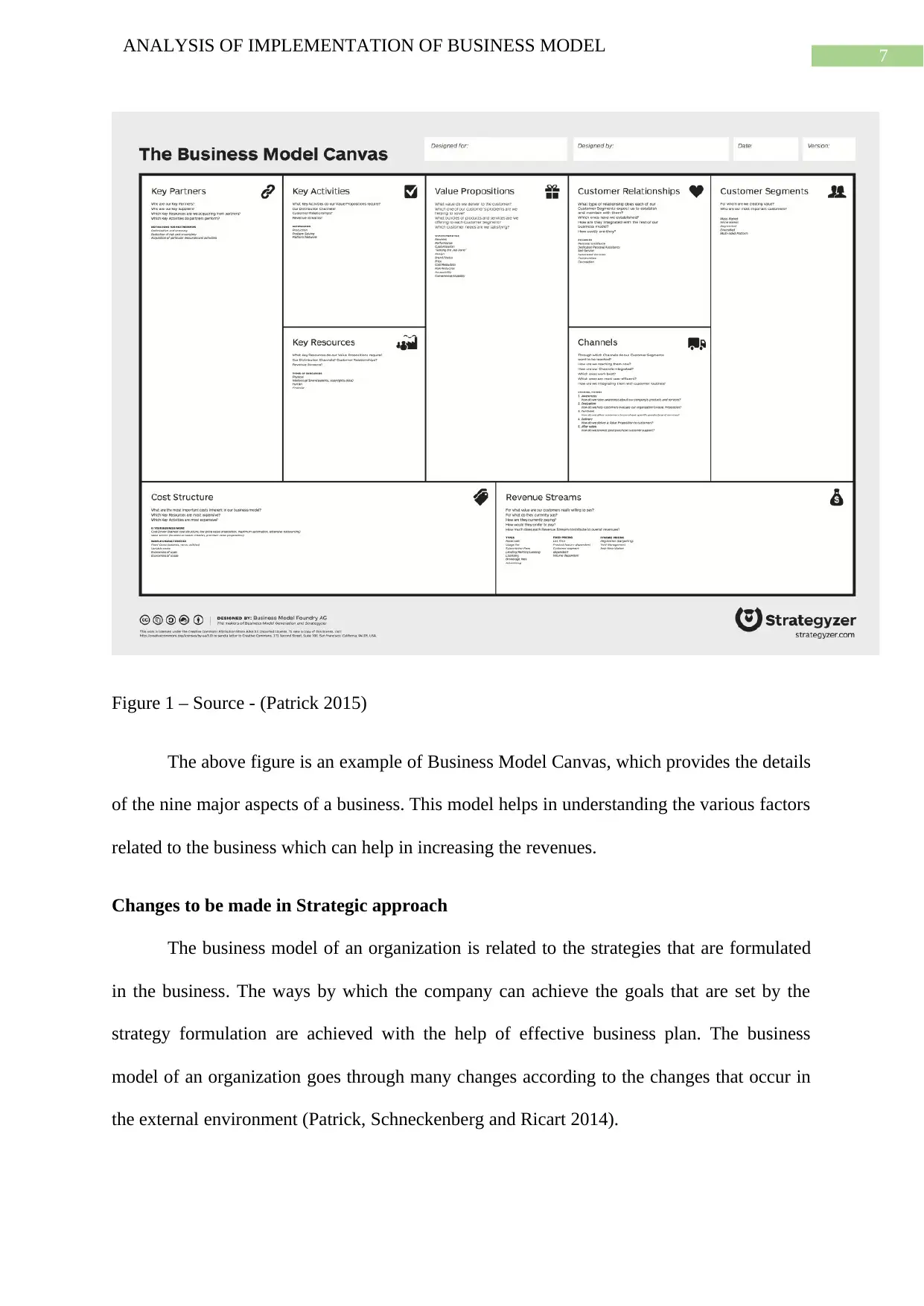
7
ANALYSIS OF IMPLEMENTATION OF BUSINESS MODEL
Figure 1 – Source - (Patrick 2015)
The above figure is an example of Business Model Canvas, which provides the details
of the nine major aspects of a business. This model helps in understanding the various factors
related to the business which can help in increasing the revenues.
Changes to be made in Strategic approach
The business model of an organization is related to the strategies that are formulated
in the business. The ways by which the company can achieve the goals that are set by the
strategy formulation are achieved with the help of effective business plan. The business
model of an organization goes through many changes according to the changes that occur in
the external environment (Patrick, Schneckenberg and Ricart 2014).
ANALYSIS OF IMPLEMENTATION OF BUSINESS MODEL
Figure 1 – Source - (Patrick 2015)
The above figure is an example of Business Model Canvas, which provides the details
of the nine major aspects of a business. This model helps in understanding the various factors
related to the business which can help in increasing the revenues.
Changes to be made in Strategic approach
The business model of an organization is related to the strategies that are formulated
in the business. The ways by which the company can achieve the goals that are set by the
strategy formulation are achieved with the help of effective business plan. The business
model of an organization goes through many changes according to the changes that occur in
the external environment (Patrick, Schneckenberg and Ricart 2014).
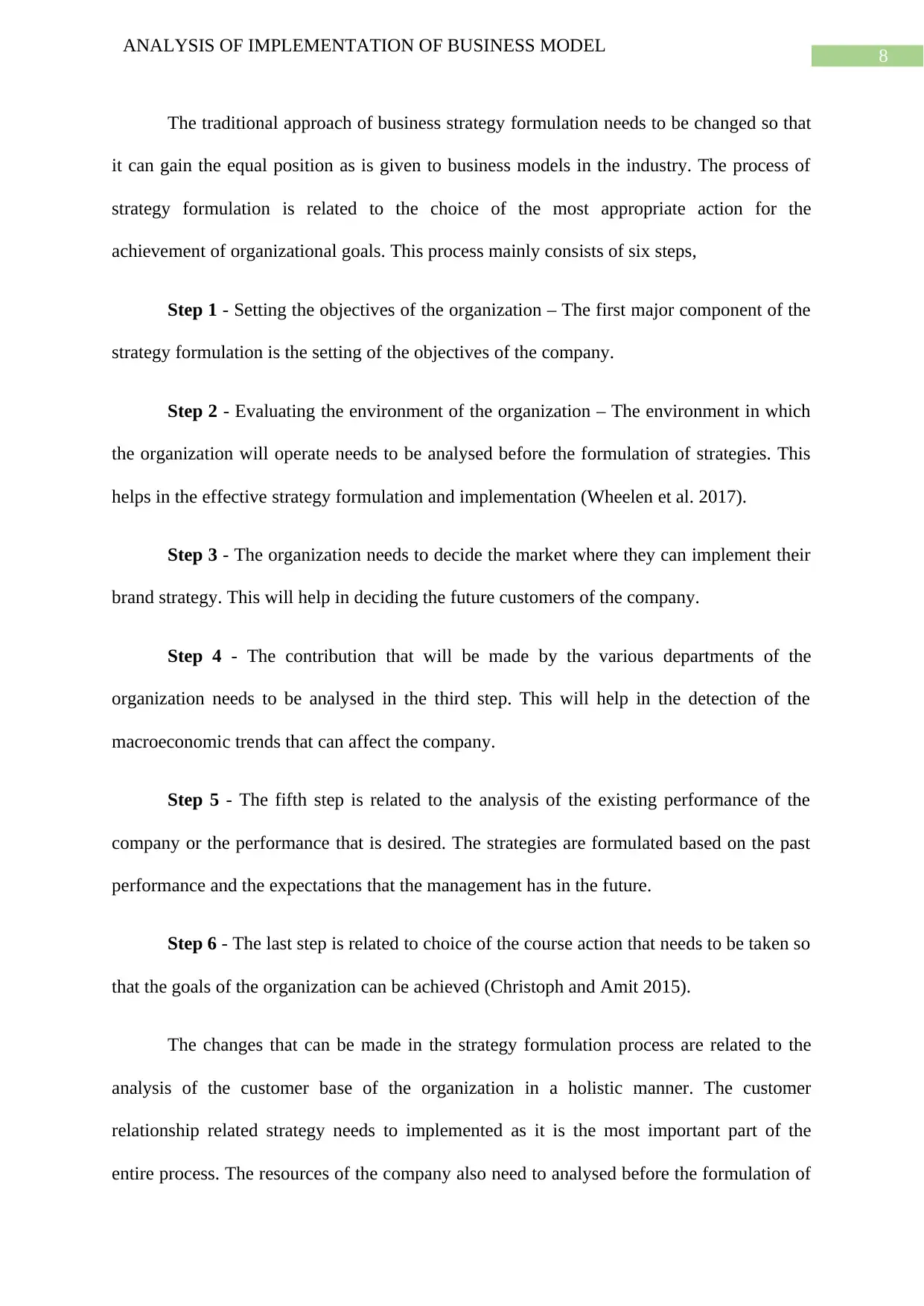
8
ANALYSIS OF IMPLEMENTATION OF BUSINESS MODEL
The traditional approach of business strategy formulation needs to be changed so that
it can gain the equal position as is given to business models in the industry. The process of
strategy formulation is related to the choice of the most appropriate action for the
achievement of organizational goals. This process mainly consists of six steps,
Step 1 - Setting the objectives of the organization – The first major component of the
strategy formulation is the setting of the objectives of the company.
Step 2 - Evaluating the environment of the organization – The environment in which
the organization will operate needs to be analysed before the formulation of strategies. This
helps in the effective strategy formulation and implementation (Wheelen et al. 2017).
Step 3 - The organization needs to decide the market where they can implement their
brand strategy. This will help in deciding the future customers of the company.
Step 4 - The contribution that will be made by the various departments of the
organization needs to be analysed in the third step. This will help in the detection of the
macroeconomic trends that can affect the company.
Step 5 - The fifth step is related to the analysis of the existing performance of the
company or the performance that is desired. The strategies are formulated based on the past
performance and the expectations that the management has in the future.
Step 6 - The last step is related to choice of the course action that needs to be taken so
that the goals of the organization can be achieved (Christoph and Amit 2015).
The changes that can be made in the strategy formulation process are related to the
analysis of the customer base of the organization in a holistic manner. The customer
relationship related strategy needs to implemented as it is the most important part of the
entire process. The resources of the company also need to analysed before the formulation of
ANALYSIS OF IMPLEMENTATION OF BUSINESS MODEL
The traditional approach of business strategy formulation needs to be changed so that
it can gain the equal position as is given to business models in the industry. The process of
strategy formulation is related to the choice of the most appropriate action for the
achievement of organizational goals. This process mainly consists of six steps,
Step 1 - Setting the objectives of the organization – The first major component of the
strategy formulation is the setting of the objectives of the company.
Step 2 - Evaluating the environment of the organization – The environment in which
the organization will operate needs to be analysed before the formulation of strategies. This
helps in the effective strategy formulation and implementation (Wheelen et al. 2017).
Step 3 - The organization needs to decide the market where they can implement their
brand strategy. This will help in deciding the future customers of the company.
Step 4 - The contribution that will be made by the various departments of the
organization needs to be analysed in the third step. This will help in the detection of the
macroeconomic trends that can affect the company.
Step 5 - The fifth step is related to the analysis of the existing performance of the
company or the performance that is desired. The strategies are formulated based on the past
performance and the expectations that the management has in the future.
Step 6 - The last step is related to choice of the course action that needs to be taken so
that the goals of the organization can be achieved (Christoph and Amit 2015).
The changes that can be made in the strategy formulation process are related to the
analysis of the customer base of the organization in a holistic manner. The customer
relationship related strategy needs to implemented as it is the most important part of the
entire process. The resources of the company also need to analysed before the formulation of
⊘ This is a preview!⊘
Do you want full access?
Subscribe today to unlock all pages.

Trusted by 1+ million students worldwide
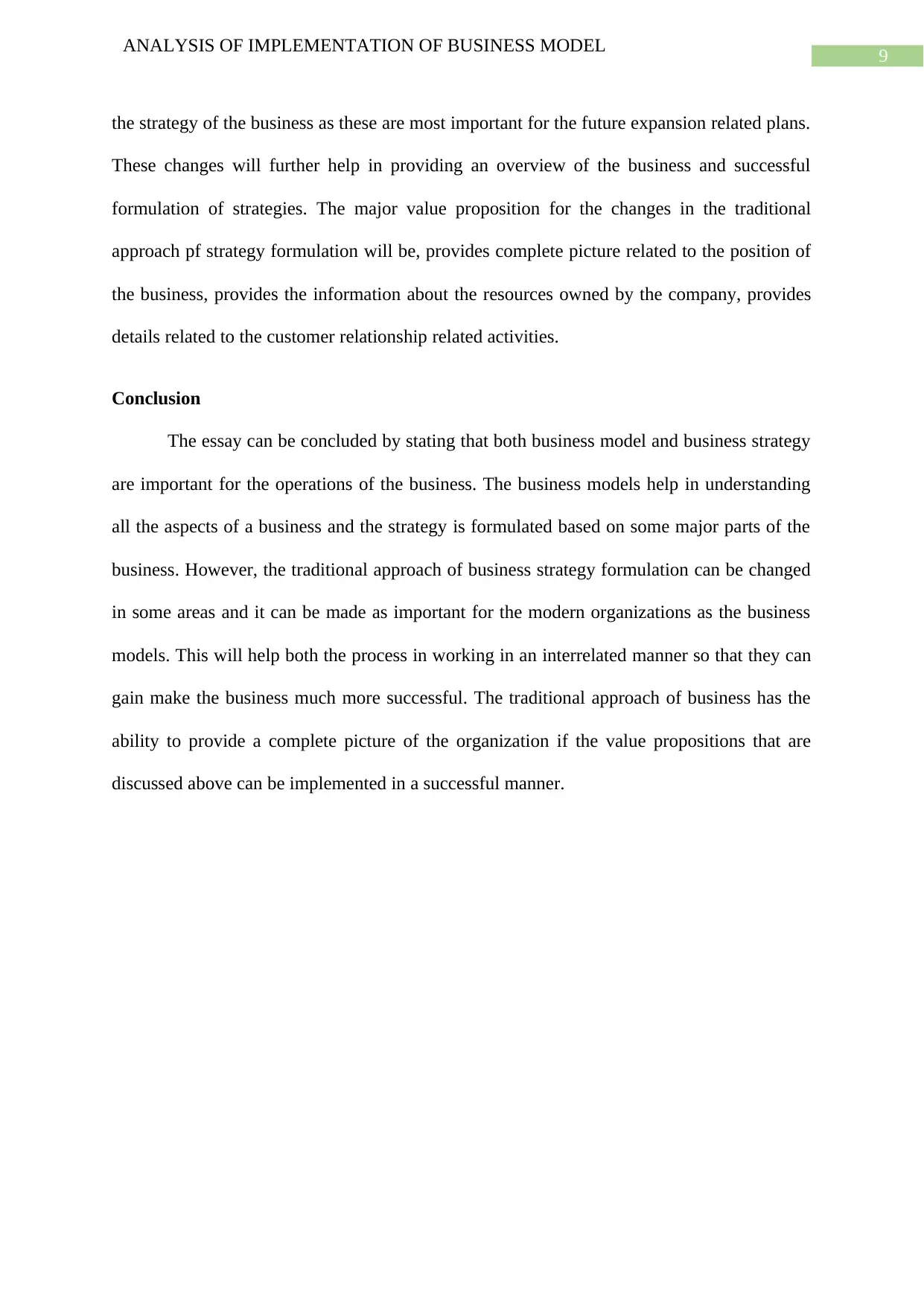
9
ANALYSIS OF IMPLEMENTATION OF BUSINESS MODEL
the strategy of the business as these are most important for the future expansion related plans.
These changes will further help in providing an overview of the business and successful
formulation of strategies. The major value proposition for the changes in the traditional
approach pf strategy formulation will be, provides complete picture related to the position of
the business, provides the information about the resources owned by the company, provides
details related to the customer relationship related activities.
Conclusion
The essay can be concluded by stating that both business model and business strategy
are important for the operations of the business. The business models help in understanding
all the aspects of a business and the strategy is formulated based on some major parts of the
business. However, the traditional approach of business strategy formulation can be changed
in some areas and it can be made as important for the modern organizations as the business
models. This will help both the process in working in an interrelated manner so that they can
gain make the business much more successful. The traditional approach of business has the
ability to provide a complete picture of the organization if the value propositions that are
discussed above can be implemented in a successful manner.
ANALYSIS OF IMPLEMENTATION OF BUSINESS MODEL
the strategy of the business as these are most important for the future expansion related plans.
These changes will further help in providing an overview of the business and successful
formulation of strategies. The major value proposition for the changes in the traditional
approach pf strategy formulation will be, provides complete picture related to the position of
the business, provides the information about the resources owned by the company, provides
details related to the customer relationship related activities.
Conclusion
The essay can be concluded by stating that both business model and business strategy
are important for the operations of the business. The business models help in understanding
all the aspects of a business and the strategy is formulated based on some major parts of the
business. However, the traditional approach of business strategy formulation can be changed
in some areas and it can be made as important for the modern organizations as the business
models. This will help both the process in working in an interrelated manner so that they can
gain make the business much more successful. The traditional approach of business has the
ability to provide a complete picture of the organization if the value propositions that are
discussed above can be implemented in a successful manner.
Paraphrase This Document
Need a fresh take? Get an instant paraphrase of this document with our AI Paraphraser
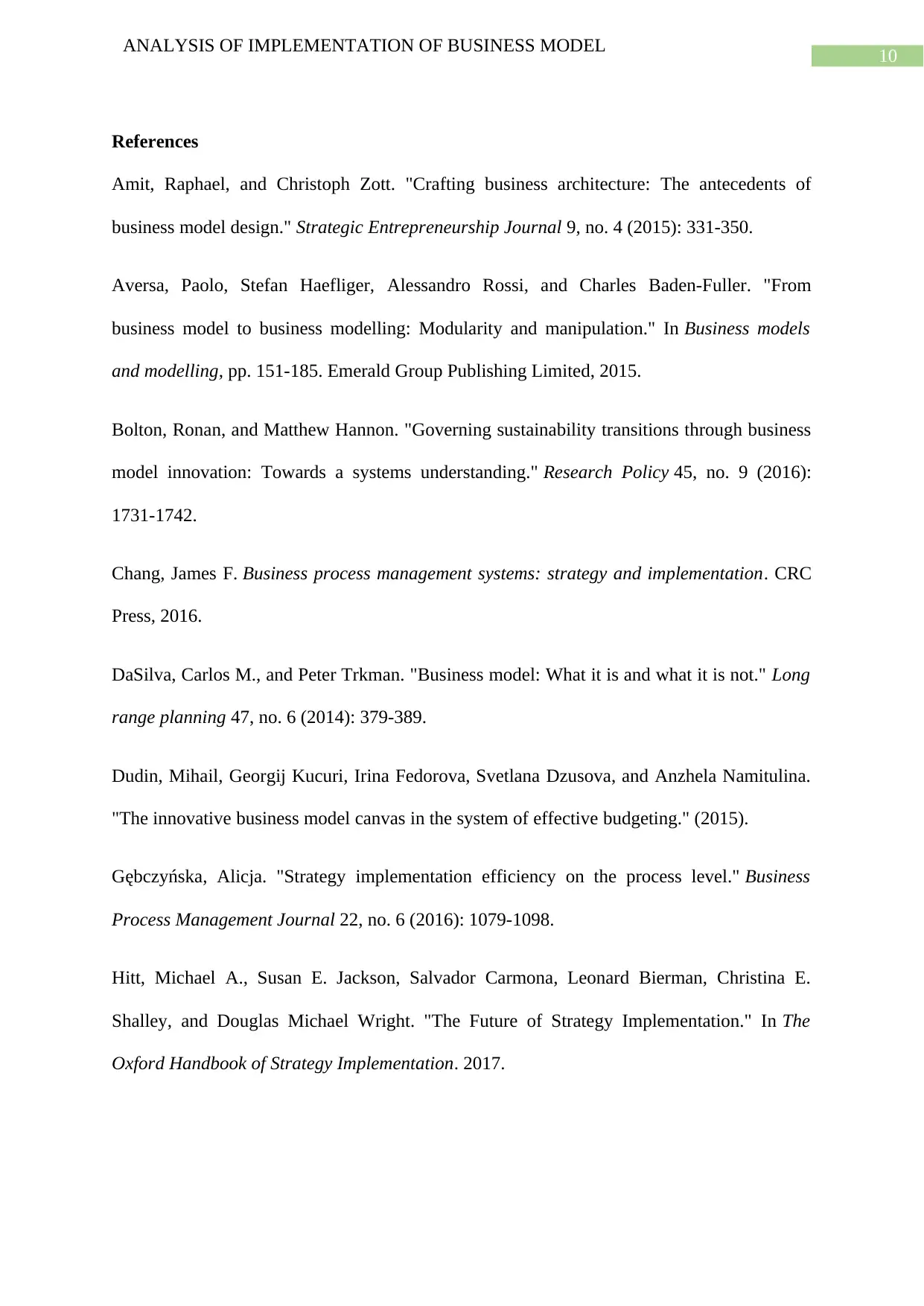
10
ANALYSIS OF IMPLEMENTATION OF BUSINESS MODEL
References
Amit, Raphael, and Christoph Zott. "Crafting business architecture: The antecedents of
business model design." Strategic Entrepreneurship Journal 9, no. 4 (2015): 331-350.
Aversa, Paolo, Stefan Haefliger, Alessandro Rossi, and Charles Baden-Fuller. "From
business model to business modelling: Modularity and manipulation." In Business models
and modelling, pp. 151-185. Emerald Group Publishing Limited, 2015.
Bolton, Ronan, and Matthew Hannon. "Governing sustainability transitions through business
model innovation: Towards a systems understanding." Research Policy 45, no. 9 (2016):
1731-1742.
Chang, James F. Business process management systems: strategy and implementation. CRC
Press, 2016.
DaSilva, Carlos M., and Peter Trkman. "Business model: What it is and what it is not." Long
range planning 47, no. 6 (2014): 379-389.
Dudin, Mihail, Georgij Kucuri, Irina Fedorova, Svetlana Dzusova, and Anzhela Namitulina.
"The innovative business model canvas in the system of effective budgeting." (2015).
Gębczyńska, Alicja. "Strategy implementation efficiency on the process level." Business
Process Management Journal 22, no. 6 (2016): 1079-1098.
Hitt, Michael A., Susan E. Jackson, Salvador Carmona, Leonard Bierman, Christina E.
Shalley, and Douglas Michael Wright. "The Future of Strategy Implementation." In The
Oxford Handbook of Strategy Implementation. 2017.
ANALYSIS OF IMPLEMENTATION OF BUSINESS MODEL
References
Amit, Raphael, and Christoph Zott. "Crafting business architecture: The antecedents of
business model design." Strategic Entrepreneurship Journal 9, no. 4 (2015): 331-350.
Aversa, Paolo, Stefan Haefliger, Alessandro Rossi, and Charles Baden-Fuller. "From
business model to business modelling: Modularity and manipulation." In Business models
and modelling, pp. 151-185. Emerald Group Publishing Limited, 2015.
Bolton, Ronan, and Matthew Hannon. "Governing sustainability transitions through business
model innovation: Towards a systems understanding." Research Policy 45, no. 9 (2016):
1731-1742.
Chang, James F. Business process management systems: strategy and implementation. CRC
Press, 2016.
DaSilva, Carlos M., and Peter Trkman. "Business model: What it is and what it is not." Long
range planning 47, no. 6 (2014): 379-389.
Dudin, Mihail, Georgij Kucuri, Irina Fedorova, Svetlana Dzusova, and Anzhela Namitulina.
"The innovative business model canvas in the system of effective budgeting." (2015).
Gębczyńska, Alicja. "Strategy implementation efficiency on the process level." Business
Process Management Journal 22, no. 6 (2016): 1079-1098.
Hitt, Michael A., Susan E. Jackson, Salvador Carmona, Leonard Bierman, Christina E.
Shalley, and Douglas Michael Wright. "The Future of Strategy Implementation." In The
Oxford Handbook of Strategy Implementation. 2017.
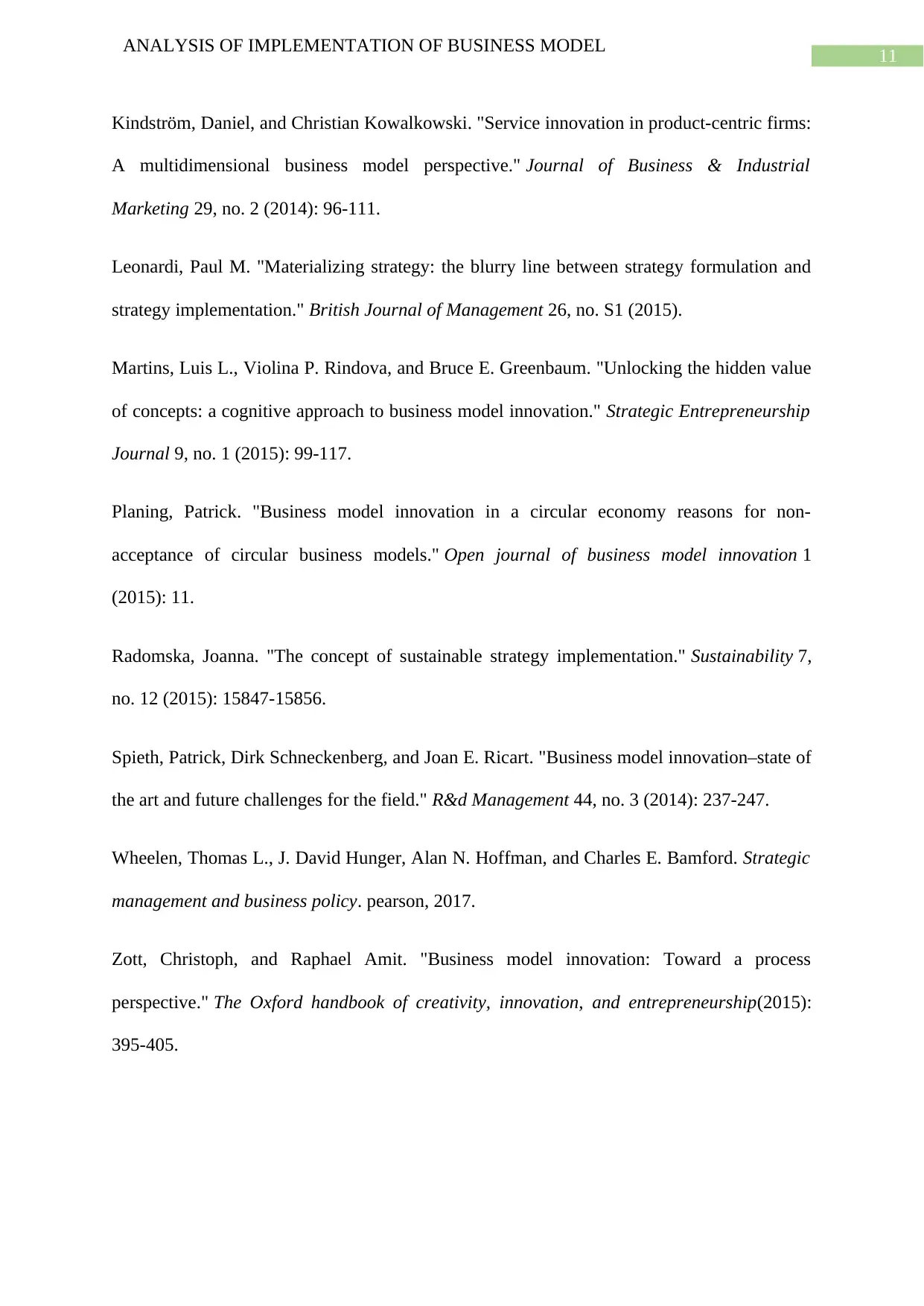
11
ANALYSIS OF IMPLEMENTATION OF BUSINESS MODEL
Kindström, Daniel, and Christian Kowalkowski. "Service innovation in product-centric firms:
A multidimensional business model perspective." Journal of Business & Industrial
Marketing 29, no. 2 (2014): 96-111.
Leonardi, Paul M. "Materializing strategy: the blurry line between strategy formulation and
strategy implementation." British Journal of Management 26, no. S1 (2015).
Martins, Luis L., Violina P. Rindova, and Bruce E. Greenbaum. "Unlocking the hidden value
of concepts: a cognitive approach to business model innovation." Strategic Entrepreneurship
Journal 9, no. 1 (2015): 99-117.
Planing, Patrick. "Business model innovation in a circular economy reasons for non-
acceptance of circular business models." Open journal of business model innovation 1
(2015): 11.
Radomska, Joanna. "The concept of sustainable strategy implementation." Sustainability 7,
no. 12 (2015): 15847-15856.
Spieth, Patrick, Dirk Schneckenberg, and Joan E. Ricart. "Business model innovation–state of
the art and future challenges for the field." R&d Management 44, no. 3 (2014): 237-247.
Wheelen, Thomas L., J. David Hunger, Alan N. Hoffman, and Charles E. Bamford. Strategic
management and business policy. pearson, 2017.
Zott, Christoph, and Raphael Amit. "Business model innovation: Toward a process
perspective." The Oxford handbook of creativity, innovation, and entrepreneurship(2015):
395-405.
ANALYSIS OF IMPLEMENTATION OF BUSINESS MODEL
Kindström, Daniel, and Christian Kowalkowski. "Service innovation in product-centric firms:
A multidimensional business model perspective." Journal of Business & Industrial
Marketing 29, no. 2 (2014): 96-111.
Leonardi, Paul M. "Materializing strategy: the blurry line between strategy formulation and
strategy implementation." British Journal of Management 26, no. S1 (2015).
Martins, Luis L., Violina P. Rindova, and Bruce E. Greenbaum. "Unlocking the hidden value
of concepts: a cognitive approach to business model innovation." Strategic Entrepreneurship
Journal 9, no. 1 (2015): 99-117.
Planing, Patrick. "Business model innovation in a circular economy reasons for non-
acceptance of circular business models." Open journal of business model innovation 1
(2015): 11.
Radomska, Joanna. "The concept of sustainable strategy implementation." Sustainability 7,
no. 12 (2015): 15847-15856.
Spieth, Patrick, Dirk Schneckenberg, and Joan E. Ricart. "Business model innovation–state of
the art and future challenges for the field." R&d Management 44, no. 3 (2014): 237-247.
Wheelen, Thomas L., J. David Hunger, Alan N. Hoffman, and Charles E. Bamford. Strategic
management and business policy. pearson, 2017.
Zott, Christoph, and Raphael Amit. "Business model innovation: Toward a process
perspective." The Oxford handbook of creativity, innovation, and entrepreneurship(2015):
395-405.
⊘ This is a preview!⊘
Do you want full access?
Subscribe today to unlock all pages.

Trusted by 1+ million students worldwide
1 out of 13
Related Documents
Your All-in-One AI-Powered Toolkit for Academic Success.
+13062052269
info@desklib.com
Available 24*7 on WhatsApp / Email
![[object Object]](/_next/static/media/star-bottom.7253800d.svg)
Unlock your academic potential
Copyright © 2020–2025 A2Z Services. All Rights Reserved. Developed and managed by ZUCOL.





